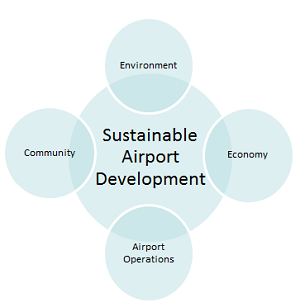Airport Sustainability
Airports

What is Sustainability?
Sustainable actions---
- Reduce environmental impacts.
- Help maintain high, stable levels of economic growth.
- Help achieve "social progress", a broad set of actions that ensure organizational goals are achieved in a way that's consistent with the needs and values of the local community.
Long-standing FAA programs such as the Noise Compatibility Program and Voluntary Airport Low Emissions (VALE) Program help airports achieve these goals. By fully integrating sustainability principles into airport planning, we are now taking sustainability a step further.
Sustainable Airport Planning
Our objective is to make sustainability a core objective in airport planning. Our efforts began in 2010 with the Sustainable Master Plan Pilot Program.
The pilot program involves funding long-range planning documents at airports throughout the United States. These documents, called Sustainable Master Plans and Sustainable Management Plans, will include initiatives for reducing environmental impacts, achieving economic benefits, and increasing integration with local communities.
Sustainable Master Plans and Management Plans
Sustainable Master Plans fully integrate sustainability into an airport's long-range planning. A Sustainable Management Plan is a stand-alone document. Both documents achieve similar objectives. They use baseline assessments of environmental resources and community outreach to identify sustainability objectives that will reduce environmental impacts, realize economic benefits, and improve community relations.
Participating Airports
The pilot began with the first Sustainable Master Plan at Ithaca-Tompkins Regional Airport in Ithaca, New York, and the first Sustainable Management Plan at Northeast Florida Regional Airport in St. Augustine, Florida. Since then, another 10 airports have joined the pilot.
Airports from most geographic regions of the United States are participating in the pilot. Airports of all sizes and activity levels are also represented. This includes some of the largest airports in the United States, General Aviation airports, and relievers.
| Airport | State |
|---|---|
| Denver International Airport | Colorado |
| Fresno Yosemite International Airport | California |
| Hartsfield-Jackson Atlanta International Airport | Georgia |
| Ithaca-Tompkins Regional Airport | New York |
| Nashville International Airport | Tennessee |
| Newark Liberty International Airport | New Jersey |
| Newport News/Williamsburg International Airport | Virginia |
| Newton City-County Airport | Kansas |
| Northeast Florida Regional Airport | Florida |
| Outagamie County Regional Airport | Wisconsin |
| Renton Municipal Airport | Washington |
| Teterboro Airport | New Jersey |
Program Guidance and Lessons Learned
In May 2010, we published interim guidance for the Sustainable Master Plan Pilot Program (see "Resources" below). We made the interim guidance purposefully broad to enable airports to develop diverse and innovative approaches to sustainability planning.
Beginning in 2012, we will summarize lessons learned from participating airports in biannual reports. We will post these reports in the "Resources" section below. We will also use the lessons learned to develop national guidance on airport sustainability.
Contact Us
Ask a question about Airport SustainabilityResources
- Interim Guidance for FAA's Sustainable Master Plan Pilot Program (PDF)
- Airport Cooperative Research Program Synthesis 10: Airport Sustainability Practices
- Sustainable Aviation Guidance Alliance's (SAGA's) Sustainability Database
Consolidated list of sustainable practices undertaken by airports
